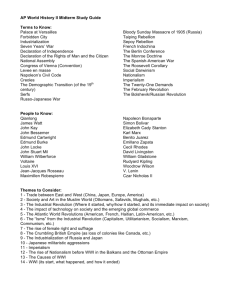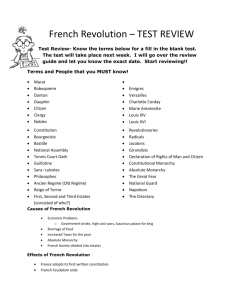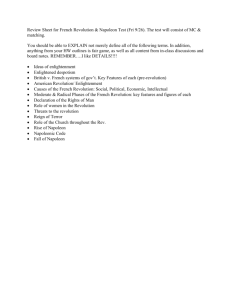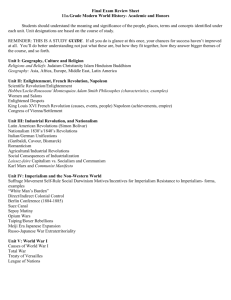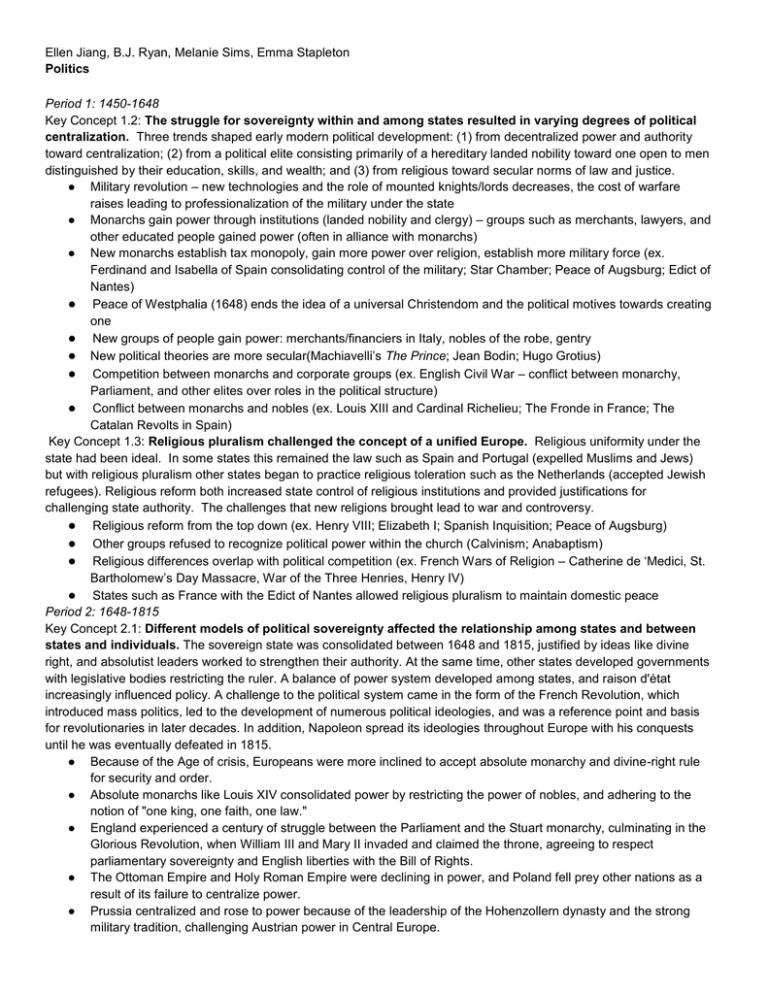
Ellen Jiang, B.J. Ryan, Melanie Sims, Emma Stapleton
Politics
Period 1: 1450-1648
Key Concept 1.2: The struggle for sovereignty within and among states resulted in varying degrees of political
centralization. Three trends shaped early modern political development: (1) from decentralized power and authority
toward centralization; (2) from a political elite consisting primarily of a hereditary landed nobility toward one open to men
distinguished by their education, skills, and wealth; and (3) from religious toward secular norms of law and justice.
● Military revolution – new technologies and the role of mounted knights/lords decreases, the cost of warfare
raises leading to professionalization of the military under the state
● Monarchs gain power through institutions (landed nobility and clergy) – groups such as merchants, lawyers, and
other educated people gained power (often in alliance with monarchs)
● New monarchs establish tax monopoly, gain more power over religion, establish more military force (ex.
Ferdinand and Isabella of Spain consolidating control of the military; Star Chamber; Peace of Augsburg; Edict of
Nantes)
● Peace of Westphalia (1648) ends the idea of a universal Christendom and the political motives towards creating
one
● New groups of people gain power: merchants/financiers in Italy, nobles of the robe, gentry
● New political theories are more secular(Machiavelli’s The Prince; Jean Bodin; Hugo Grotius)
● Competition between monarchs and corporate groups (ex. English Civil War – conflict between monarchy,
Parliament, and other elites over roles in the political structure)
● Conflict between monarchs and nobles (ex. Louis XIII and Cardinal Richelieu; The Fronde in France; The
Catalan Revolts in Spain)
Key Concept 1.3: Religious pluralism challenged the concept of a unified Europe. Religious uniformity under the
state had been ideal. In some states this remained the law such as Spain and Portugal (expelled Muslims and Jews)
but with religious pluralism other states began to practice religious toleration such as the Netherlands (accepted Jewish
refugees). Religious reform both increased state control of religious institutions and provided justifications for
challenging state authority. The challenges that new religions brought lead to war and controversy.
● Religious reform from the top down (ex. Henry VIII; Elizabeth I; Spanish Inquisition; Peace of Augsburg)
● Other groups refused to recognize political power within the church (Calvinism; Anabaptism)
● Religious differences overlap with political competition (ex. French Wars of Religion – Catherine de ‘Medici, St.
Bartholomew’s Day Massacre, War of the Three Henries, Henry IV)
● States such as France with the Edict of Nantes allowed religious pluralism to maintain domestic peace
Period 2: 1648-1815
Key Concept 2.1: Different models of political sovereignty affected the relationship among states and between
states and individuals. The sovereign state was consolidated between 1648 and 1815, justified by ideas like divine
right, and absolutist leaders worked to strengthen their authority. At the same time, other states developed governments
with legislative bodies restricting the ruler. A balance of power system developed among states, and raison d'état
increasingly influenced policy. A challenge to the political system came in the form of the French Revolution, which
introduced mass politics, led to the development of numerous political ideologies, and was a reference point and basis
for revolutionaries in later decades. In addition, Napoleon spread its ideologies throughout Europe with his conquests
until he was eventually defeated in 1815.
● Because of the Age of crisis, Europeans were more inclined to accept absolute monarchy and divine-right rule
for security and order.
● Absolute monarchs like Louis XIV consolidated power by restricting the power of nobles, and adhering to the
notion of "one king, one faith, one law."
● England experienced a century of struggle between the Parliament and the Stuart monarchy, culminating in the
Glorious Revolution, when William III and Mary II invaded and claimed the throne, agreeing to respect
parliamentary sovereignty and English liberties with the Bill of Rights.
● The Ottoman Empire and Holy Roman Empire were declining in power, and Poland fell prey other nations as a
result of its failure to centralize power.
● Prussia centralized and rose to power because of the leadership of the Hohenzollern dynasty and the strong
military tradition, challenging Austrian power in Central Europe.
●
●
Peter the Great initiated reforms that westernized Russia eliminated the feudal organs of self government.
States like Austria, Russia, and Prussia initiated reforms, experimenting with “enlightened absolutism,” although,
with the exception of Joseph II, the rulers mostly viewed enlightened ideals as a tool to exercise power.
● The French Revolution established challenged the political order, establishing first a constitutional monarchy
and then a republic, and increasing popular participation.
● After a coalition defeated Napoleon, the Congress of Vienna tried to restore the balance of power and contain
nationalist upheavals.
Key Concept 2.3: The dissemination of the Scientific Revolution and the application of its methods to political,
social, and ethical issues led to an increased, although not unchallenged, emphasis on reason in European
culture. Following the Scientific Revolution, intellectuals tried to apply the methods of science, such as empiricism,
mathematics, and skepticism, to other affairs, including political theory.
● In John Locke’s Second Treatise on Government, he viewed the state of nature as having humans freely enjoy
inalienable rights. In order the protect those rights, individuals create a social contract with a government and
have the right to rebellion should the government abuse its power and break the contract.
● Also rejecting divine right and devising a secular justification, Thomas Hobbes explained the state of nature as
full of conflict continual war. He believed that individuals enter into a social contract to end the chaos, and one
all powerful sovereign absorbs the power of everyone, with rebellion being prohibited.
● Montesquieu applied methods of scientific study to politics and government, concluding that geography, climate,
and history determined the forms of government and laws of a nation. He advocated a system of checks,
influencing future governments.
● Rousseau’s Social Contract expressed that a political system must find a form of political association so that the
General Will could be realized but left the exact structure of this republican state ambiguous.
Period 3: 1815-1914
Key Concept 3.1: The Industrial Revolution spread from Great Britain to the continent, where the state played a
greater role in promoting industry. Although the Industrial Revolution was first and foremost a technological change,
the degree to which government was involved dictated its dissemination and effects. In Britain, the Industrial Revolution
happened largely by accident and chance. The desire for independence from foreign textiles led to the first factories,
powered by steam engines created as a cheap method of removing water from mines. The British government also
created a climate in which individualism was encouraged and private enterprise was acceptable. Because of this freer
culture, the Industrial Revolution was able to take full effect in Britain without the need for government motivation.
However, in other nations, the drive to catch up to a perceived threat led to an approach based more on a top-down
system in which the government directly controlled industry.
● France followed a far different approach, industrializing slowly and with the government playing a key role.
● Prussia’s quick industrialization allowed it to become the power center in a rising Germany headed towards
unity, evidenced by the trade agreement called the Zollverein.
● Eastern and southern Europe lagged behind, due to a complex interplay of factors such as geographic isolation,
the persistence of serfdom in the East, and lack of government support.
Key Concept 3.3: The problems of industrialization provoked a range of ideological, governmental, and
collective responses. Industrialization effectively gave birth to some of the most influential political theories of the
twentieth century and even today. This ideologies clashed most notably in the Revolutions of 1848, where conservative
monarchs put down nationalist, socialist, and liberalist uprisings. This “turning point at which history failed to turn” left
many issues unresolved until far into the twentieth century. As a result of the Revolutions, however, political parties
developed into coherent, powerful organizations able to mobilize their members for action. Governments did attempt
reform to address some issues, however. George Haussmann’s reform through parks and new infrastructure of Paris
inspired so-called “Haussmannization” in other European and world cities. There were many idealists who still saw
European society as too corrupt and attempted to establish their own communities separate from the rest of society.
Ideologies:
● Liberalism: literally “free,” liberals believed in a minimalist government elected by popular sovereignty that
respected individual rights but debated the extent to which all groups in society should actively participate in its
governance; the best example in modern politics is the Libertarian Party of Ron Paul (ex. Jeremy Bentham:
founded utilitarianism (“greatest good for the greatest number”); Anti-Corn Law League: British group that
opposed the Corn Laws, which taxed imported grain and thus raised bread prices; John Stuart Mill: criticized
Bentham for ignoring emotions; David Ricardo: iron law of wages (wages stabilize as subsistence level))
● Conservativism: the core principles were that human nature was not perfectible, and thus traditional power
structures like autocratic governments and religion were necessary for society to function; there is no modern
political party that really adheres to this version of conservativism (ex. Edmund Burke, Joseph de Maistre,
Klemens von Metternich: Austrian minister of foreign affairs who directed the Congress of Vienna)
● Socialism/Marxism: Begun by utopian socialists, the leftist ideology became much clearer and “scientific” in its
critique of capitalism under the ideas of Karl Marx and Friedrich Engels
○ Utopian socialists examples: Henri de Saint-Simon, Charles Fourier, Robert Owen, Pierre-Joseph
Proudhon
○ Marxists examples: Friedrich Engels: Marx’s close friend and collaborator who made Marx’s views
easier to understand to the general public, August Bebel, Clara Zetkin, Rosa Luxemburg
● Anarchism: This was a relatively simple idea: government in all forms should be dissolved in favor of a society
based on voluntary cooperation (ex. Mikhail Bakunin, Georges Sorel)
● Nationalism: one of the most widely-appealing ideologies, nationalism professed loyalty and glory to one’s
country and/or ethnic group through political unification, liberal reform, romantic idealism, and racism with a
large amount of anti-Semitism
○ Nationalism examples: J.G. Fichte, Grimm Brothers: collected old German fairy tales in a massive
anthology, Giuseppe Mazzini: leader of Italian unification movement called Young Italy, Pan-Slavists:
held a Congress in Prague in 1848 to discuss and organize for a state encompassing all of the Slavic
peoples
○ Anti-Semitism examples: Dreyfus Affair: Jewish military officer scapegoated for murder; Emile Zola
wrote J’accuse in response, Christian Social Party in Germany, Karl Lueger, mayor of Vienna
Key Concept 3.4: European states struggled to maintain international stability in an age of nationalism and
revolutions. The beginning of the time period marked recovery from Napoleon’s upheaval. Through the Congress of
Vienna, policy revolved around stability and prevention of war often without regard to minorities, leading to nationalist
dissent. New forms of conservative leaders used nationalism to rule in the name of “the people.” Out of this time rose
the focus of nation building in the 1850s-1870s where leaders such as Bismarck favored a Realpolitik approach. In
addition, previously unified states like France, Russia, and Austria-Hungary worked toward better stability through
reform.
● After the break down of the Concert of Europe, conservative leaders co-opted the agenda of nationalists for the
purposes of creating or strengthening the state (Ex. Bismarck, Napoleon III, Cavour)
● Cavour and Bismarck used Realpolitik strategies to unify their countries using military as an aid as well (Ex.
Garibaldi's military campaigns in Italy; Bismarck industrialized warfare and weaponry in Germany)
● In France, Napoleon III founded the Credit Mobiliér bank, built railways, promoted industry, and rebuilt the city of
Paris with Baron von Haussmann. However, after defeat in the Franco-Prussian War when Napoleon was
captured, the Third Republic was established.
● In Russia, Alexander II abolished serfdom, created zemstvos (local assemblies) and abolished corporal and
capital punishment. However, anarchism gained support, and the People’s Will assassinated Alexander.
● In Austria-Hungary, Franz Joseph I focused on internal development, building railroads and promoting industry
and created the Dual Monarchy, allowing more autonomy for Hungary.
Key Concept 3.5: A variety of motives and methods led to the intensification of European global control and
increased tensions among the Great Powers. Political forces were some of the most important driving forces in
second-wave European imperialism. They took a variety of forms, from strategic geography to nationalism to the
importance of colonies for winning elections.
● Many European nations sought colonies for their geographic value. Great Britain established a protectorate over
Egypt in order to build and control the Suez Canal, which was viewed as a “lifeline to the British Empire,” most
specifically India. The United States annexed Hawaii in part for its plantations and economic value, but also as a
coaling station for ships travelling across the Pacific, as was the same with the Philippines.
● Nationalism (with roots in public opinion) was an even larger factor in the European drive for colonies. Otto von
Bismarck disliked colonies but said that they were “for elections.” Nationalism led many nations not typically
considered imperial powers to claim colonies for status, like Italy’s invasion of Libya, Eritrea, and the Italian
Somaliland.
●
The 1884-1885 Berlin Conference was called by Bismarck and inspired by Leopold II’s taking of the Belgian
Congo. At it, the European powers agreed to divide up Africa, leading to the eventual end of African
independence in all parts of the continent except Liberia and Ethiopia.
Period 4: 1914-present
Key Concept 4.1: After WWI, European politics was in unstable conditions formed by both the Treaty of
Versailles and the League of Nations. Economic turmoil and weak governments allowed for the rise of extremist
governments. Decolonization and total war created political vacuums and tensions in both the colonies and European
states which allowed for the start of the Cold War politically dividing the world between Communism and Democracy.
With the end of the cold war, European politics focuses on reparation and coming together.
● Great Depression in the 30s heightened post-war tensions and weakened government’s control over society
● After WWI, newly formed democracies, such as the Weimar Republic in Germany, were too weak to suppress
the rise of extremist leaders (Hitler)
● After WWII, colonial nationalist movements made decolonization widespread. (Gandhi’s peaceful protests in
India)
● Devastation, political vacuums, and tensions culminated into the Cold War politically dividing the world between
Communism and Democracy with the Berlin Wall.
● After fall of Communism in 1989, European politics switched to a focus on unity and reparation (the EU and
NATO).
● Tensions from the Cold War did spur many Nationalist movements and parties in Western Europe such as the
crisis of 1968.
Key Concept 4.2: The stresses of total war required centralization of political control during the war, which
ultimately lead distrust of authority. The end of the European empires left weak democracies in their places. The rise
of Fascism lead to the start of WW2, which ended and divided the world between communism and democracy.
European governments generally increased their involvement in citizen’s lives. After the collapse of communism, the
switch to capitalism and democracy began.
● The Russian Revolution in 1917 created a regime based on Marxist-Leninist theory
● After WWI, the four empires, German, Austro- Hungarian, Ottoman, and Russian, dissolved leaving weak
governments in their place.
● Fascism found it essential that they have revenge for the wrongs done to them in the Treaty of Versailles, such
as Hitler’s goal in Germany to avenge the wrongs of the Treaty of Versailles
● Italy and Germany both experienced the rise of Fascism by strong, charismatic leaders(Hitler and Mussolini)
● America resorted to a policy of containment during the Cold War
● Mikhail Gorbachev’s policies and reforms, such as perestroika and glasnost, led to the collapse of communist
governments in Eastern Europe and the fall of the Soviet Union
● Welfare, education, greater planning and regulation of the economy, and cultural opportunities were extended
● Former communist states moved for admission into the European Union and the North Atlantic Treaty
Organization (NATO)
Key Concept 4.4: Amidst the extreme suffering and destruction of the wars, urbanization and increased
standards of living increased during the 20th century. Europe’s increased involvement in a global-scale economy
allowed people access to a wider range of goods, ideas, and practices. While Europeans began to question their cultural
identities, traditional institutions of power and values began to be challenged. These new voices in society gained
prominence in political, intellectual, and social topics.
● Governments began instituting family policies supporting child care and large-scale guest-worker programs
increasing standard of living
● After the disruptions of war and decolonization, Europeans were faced with an influx of immigrants leading to
uncertainties of European cultural identity.
● Feminist movements also gave women a greater role in society: women finally gained the vote, greater
educational opportunities, and access to professional careers, even while continuing to face social inequalities.
● Traditional institutions of power and values began to be opposed and challenged by a new generation calling for
greater political and personal freedom such as the 1968 student protests in France, and the gay and lesbian
movements working for expanded civil rights.
Works Cited
"Anti-Corn Law League." World History: The Modern Era. ABC-CLIO, 2014. Web. 3 May
2014.
Freiler, Chris. Advanced Placement European History Exam Preparation Guide. New York:
Mcgraw-Hill, 2008. Print.
Kishlansky, Mark A., Civilization in the West. New York: Pearson Longman, 2006. Print.

